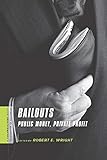Bailouts : Public Money, Private Profit / ed. by Robert Wright.
Material type: TextSeries: A Columbia / SSRC Book (Privatization of Risk)Publisher: New York, NY : Columbia University Press, [2010]Copyright date: ©2010Description: 1 online resource (160 p.)Content type:
TextSeries: A Columbia / SSRC Book (Privatization of Risk)Publisher: New York, NY : Columbia University Press, [2010]Copyright date: ©2010Description: 1 online resource (160 p.)Content type: - 9780231150552
- 9780231521734
- Bailouts (Government policy)
- Bank failures -- United States
- Corporate reorganizations -- United States
- Corporate turnarounds -- United States
- Finance - Government policy - United States
- Finance -- Government policy -- United States
- Financial crises -- United States
- Intervention (Federal government) -- United States
- POLITICAL SCIENCE / Public Policy / Economic Policy
- 338.973/02 338.97302
- HB3722 .B35 2010
- HB3722 .B35 2010
- online - DeGruyter
- Issued also in print.
| Item type | Current library | Call number | URL | Status | Notes | Barcode | |
|---|---|---|---|---|---|---|---|
 eBook
eBook
|
Biblioteca "Angelicum" Pont. Univ. S.Tommaso d'Aquino Nuvola online | online - DeGruyter (Browse shelf(Opens below)) | Online access | Not for loan (Accesso limitato) | Accesso per gli utenti autorizzati / Access for authorized users | (dgr)9780231521734 |
Frontmatter -- Contents -- Introduction. To Bail or Not to Bail? -- 1. Hybrid Failures and Bailouts. Social Costs, Private Profits -- 2. Financial Crises and Government Responses. Lessons Learned -- 3. The Evolution of the Reconstruction Finance Corporation as a Lender of Last Resort in the Great Depression -- 4. After the Storm. The Long-Run Impact of Bank Bailouts -- Contributors
restricted access online access with authorization star
http://purl.org/coar/access_right/c_16ec
Today's financial crisis is the result of dismal failures on the part of regulators, market analysts, and corporate executives. Yet the response of the American government has been to bail out the very institutions and individuals that have wrought such havoc upon the nation. Are such massive bailouts really called for? Can they succeed?Robert E. Wright and his colleagues provide an unbiased history of government bailouts and a frank assessment of their effectiveness. Their book recounts colonial America's struggle to rectify the first dangerous real estate bubble and the British government's counterproductive response. It explains how Alexander Hamilton allowed central banks and other lenders to bail out distressed but sound businesses without rewarding or encouraging the risky ones. And it shows how, in the second half of the twentieth century, governments began to bail out distressed companies, industries, and even entire economies in ways that subsidized risk takers while failing to reinvigorate the economy. By peering into the historical uses of public money to save private profit, this volume suggests better ways to control risk in the future.Additional Columbia / SSRC books on the privatization of risk and its implications for Americans:Health at Risk: America's Ailing Health System--and How to Heal ItEdited by Jacob S. HackerLaid Off, Laid Low: Political and Economic Consequences of Employment InsecurityEdited by Katherine S. NewmanPensions, Social Security, and the Privatization of RiskEdited by Mitchell A. Orenstein
Issued also in print.
Mode of access: Internet via World Wide Web.
In English.
Description based on online resource; title from PDF title page (publisher's Web site, viewed 02. Mrz 2022)


